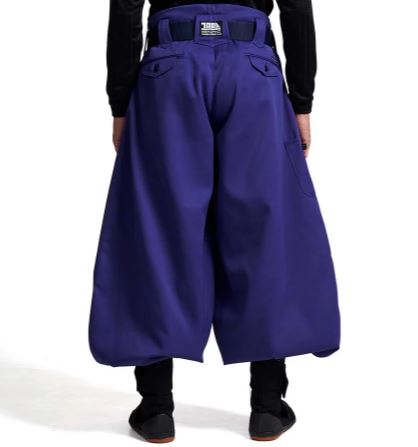Japanese tobi pants are not just another pair of work trousers—they’re a blend of culture, craftsmanship, and functionality. Known for their distinctively wide silhouette, tight ankle cuffs, and cultural significance, tobi pants have become an icon within Japan’s workwear landscape. Originating in the construction trades, they have since made a mark in streetwear, celebrated for their unique look and practical features.
1. Origins and History of Japanese Tobi Pants
Tobi pants trace their roots back to Japanese laborers, particularly those in the construction and carpentry fields, often referred to as "tobi-shokunin." The term "tobi" translates to "kite," symbolizing the aerial acrobatics these workers perform while balancing at great heights. Traditionally, Japanese tobi pants were crafted to provide flexibility, protection, and a unique visual style. Today, they hold an iconic status in both Japanese work culture and urban fashion, a nod to their longstanding history and symbolic connection to Japanese craftsmanship.
2. Distinctive Design Features
One of the standout characteristics of Japanese tobi pants is their unique, exaggerated balloon-like shape around the thighs and knees, tapering tightly at the ankles. This design isn’t solely for aesthetics—it enhances freedom of movement while also minimizing interference with the worker’s tasks. The fitted ankles prevent tripping, while the roomy upper half allows for an impressive range of motion, perfect for scaling buildings or navigating challenging job sites.
Materials and Craftsmanship
Crafted from durable, often heavy-duty fabrics, tobi pants are built to withstand wear and tear while retaining a flexible structure. Traditional tobi pants are usually made from thick cotton or synthetic blends that offer protection without sacrificing comfort. The quality of fabric, combined with meticulous stitching techniques, gives Japanese tobi pants their resilience and iconic look.
3. Practical Benefits for Laborers
For construction workers and craftsmen, tobi pants provide practical advantages that standard workwear cannot match. The roominess around the hips and knees allows workers to stretch, bend, and climb without restriction. In Japan, laborers are frequently seen scaling bamboo scaffolding, a job that requires exceptional agility. The design of Japanese tobi pants allows for these complex maneuvers, providing a protective yet unrestrictive garment that meets the demands of these labor-intensive roles.
Tool Storage and Accessibility
Another essential feature of Japanese tobi pants is the integration of tool pockets and loops. Many tobi pants come equipped with reinforced loops and pouches, enabling wearers to carry essential tools and materials easily. This added functionality allows workers to keep their hands free, adding to the pants' practicality on construction sites and in workshops.
4. Style Meets Function: Streetwear and Tobi Pants
Beyond workwear, tobi pants have captured the attention of fashion-forward individuals worldwide. Their bold silhouette and undeniable uniqueness have made them a staple in Japanese streetwear, blending functionality with style. Fashion enthusiasts appreciate how the pants’ structure can add a unique dimension to their wardrobe, often pairing them with oversized tops or jackets to balance the look. In streetwear, Japanese tobi pants represent a rebellious edge, honoring the hard work and cultural roots that shaped them.
5. Cultural Significance and Symbolism
In Japanese culture, clothing often reflects values, professions, or social status. Tobi pants signify more than just workwear—they are a symbol of respect for traditional trades and the dedication of Japanese craftsmen. For tobi-shokunin, these pants carry pride and identity, reflecting a long-standing tradition of skill and labor. Wearing Japanese tobi pants can be seen as a tribute to this culture, blending practicality with deep cultural symbolism.
6. Variations and Modern Adaptations
While traditional tobi pants are recognizable by their wide-to-narrow cut, modern designs have introduced new elements. Some versions incorporate different fabrics or patterns, and the silhouette has seen minor adjustments to cater to changing fashion trends. Lightweight variations are available for warmer climates, while winter styles might use fleece lining for insulation. These adaptations make Japanese tobi pants versatile, allowing both laborers and style enthusiasts to embrace this unique fashion item in a variety of settings.
Fusion with Western Fashion Trends
In recent years, the popularity of Japanese tobi pants has extended beyond Japan, with Western brands and designers taking inspiration from this functional workwear. The mix of traditional Japanese craftsmanship and modern design elements appeals to a global audience, making tobi pants a popular choice for individuals seeking bold, unconventional style.
7. Buying Tips and Where to Find Authentic Tobi Pants
When looking to purchase authentic Japanese tobi pants, it’s essential to consider quality, fit, and fabric. Reliable retailers like the Japan Zone Store offer genuine tobi pants crafted in Japan, ensuring high standards in both materials and construction. When choosing a pair, prioritize durability and comfort, especially if you intend to wear them for work. Authentic brands maintain the true essence of tobi pants, allowing buyers to experience the unique combination of tradition and functionality that defines this garment.
Conclusion
In summary, Japanese tobi pants are an embodiment of cultural heritage, practical design, and contemporary style. From their origins in Japanese construction trades to their evolution as a global fashion statement, these pants hold a unique place in both workwear and streetwear. Their distinctive silhouette, durable fabric, and flexibility make them a top choice for laborers, while their cultural symbolism and bold look attract fashion enthusiasts. Whether for work or fashion, Japanese tobi pants are a one-of-a-kind garment with a story woven into every seam.
Also, follow our Facebook page to get the latest updates





